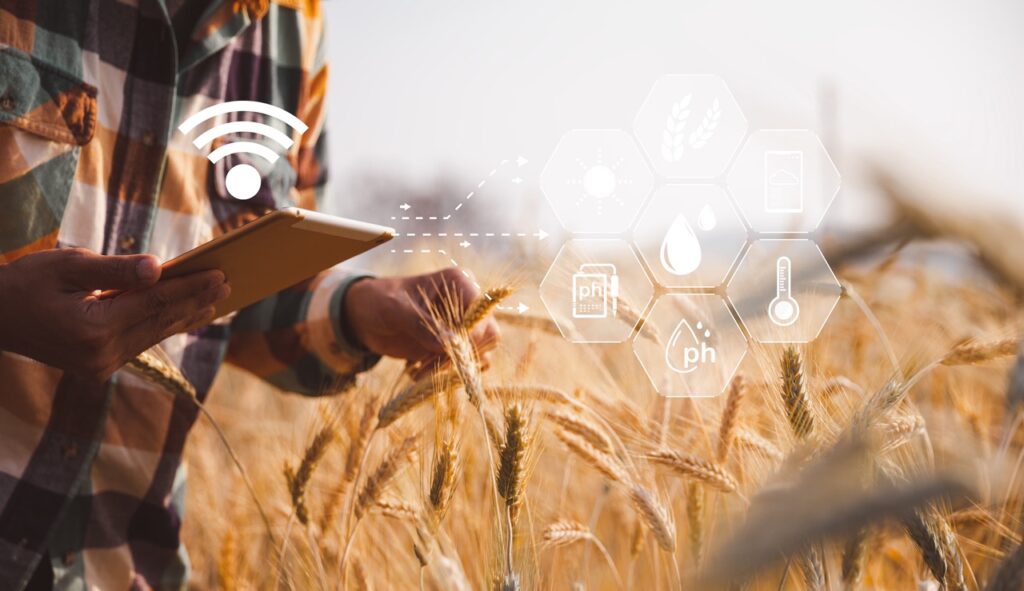
Our exploration of terminology related to the Industrial Internet of Things.
The tech world is full of buzzwords and terms unfamiliar to most people, many of which you can ignore. But there comes a time when it’s essential to walk the walk and talk the talk. Our IIoT glossary comes in handy for those moments.
Here is a list of relevant IIoT terms we think you should know.
Access Control
Access control ensures that asset access is limited to authorized personnel and is restricted based on security and business requirements.
Ambient Computing
Ambient computing is the evolution and combination of gesture and voice interfaces, speech recognition, cloud computing, wearable computing, IoT, augmented reality, AI and machine learning, and the quantified self.
Analytics
Analytics is a systematic analysis of information (data) or statistics for the discovery, communication, and interpretation of meaningful data patterns for better decision-making.
Application Domain
An application domain is a functional domain for application logic implementation.
Artificial Intelligence
Artificial Intelligence (AI) is the development and theory of systems that can perform tasks typically requiring human intelligence, like speech, visual perception, decision-making, language translation, and speech recognition.
Asset
Assets are mission-critical systems, physical hardware, applications, support systems, high-impact programs, personnel, equipment, locations, and more.
Attack Surface
Attack surface refers to the system elements and interactions that are vulnerable to cyberattacks.
Attack Vector
An attack vector is a pathway by which a cybercriminal can gain access to an entity.
Autonomy
Autonomy is an intelligent system’s ability to independently create and select different courses of action to achieve goals based on the system’s understanding and knowledge of the world and other factors.
Brownfield
Brownfield refers to an existing industrial system targeted for new functionalities with zero operational disruptions.
Business Intelligence
Business intelligence refers to the applications, technologies, and practices for collecting, analyzing, and integrating business data to support improved business decision-making.
Business Viewpoint
A business viewpoint is an architecture viewpoint used to describe the purpose of establishing an IoT system by encompassing a business’s vision, mission, values, and objectives.
Cloud Computing
Cloud computing is a term used to describe the delivery of computing services over the Internet.
Computer Network
A computer network is a collection of interconnected endpoints in a many-to-many arrangement.
Connectivity
Connectivity refers to a system or application’s ability to communicate with other systems, networks, or applications.
Connectivity Endpoint
Connectivity endpoints are interfaces that provide connectivity.
Control Domain
Control domains are functional domains for industrial control system implementations.
Cross-Cutting Concern
A cross-cutting concern impacts an entire system and may also affect multiple architectural viewpoints.
Cross-Cutting Function
A cross-cutting function is one that can be applied across multiple functional architectural domains to address cross-cutting concerns.
Cryptography
Cryptography exemplifies the means, principles, and mechanisms for data transformation to hide information to prevent its undetected modification or unauthorized use.
Data at Rest
Data at rest is stored data that is not processed or transferred.
Data Center
A data center is a facility that contains connected equipment for computing resources.
Data in Motion
Data in motion is information that’s transferred from one location to another.
Data in Use
Data in use is information that’s being processed.
Data Integrity
Data integrity proves that data hasn’t been tampered with, altered, or destroyed in an unauthorized way.
Databus
Databus is a data-centric sharing system where applications exchange information in a virtual, global data space.
Denial of Service (DoS)
Denial of service prevents unauthorized access to resources. It also prevents time-critical operation delays.
Digital Twin
A digital twin, also called a virtual doppelganger, is a three-dimensional representation of IoT-enabled physical assets that can show how the asset is functioning.
ECM (Electronically Commutated Motor Technology)
ECM is a smart pump technology that is becoming more common in HVAC and commercial building markets.
Edge
The edge is the boundary between pertinent physical and digital entities, delineated by IIoT devices.
Edge Computing
Edge Computing encompasses the space between the network’s core and its endpoints, like local servers, including devices and infrastructure. It also includes essential network gateways that collect data and preliminary analytics before sending the information back to the core for more processing.
Emergent Behavior
Emergent Behavior is the behavior of a system created by the interactions of its component.
Encryption
Encryption is a scrambling method using a cryptographic algorithm so that only authorized people can understand the data.
Endpoint
Endpoints are components with computational capabilities and network connectivity.
Environment
Environment refers to the circumstances and setting of all IT system interactions, including infrastructure, hardware, systems, and software.
Functional Component
Functional components are necessary JavaScript actions. They are typically arrow functions but can also be made using the regular function keyword. Functional components are also often called “stateless” or “dumb” because they accept display data in a form mostly responsible for rendering UI (User Interface).
Functional Domain
Functional domain refers to the collection of functions that make up a system.
Functional Framework
Functional frameworks are sets of abstract and reusable functional components that can be customized, extended, and applied to many applications in a specific domain.
Functional Viewpoint
Functional viewpoints are architecture viewpoints that frame concerns specific to the structure and functional capabilities of IoT (Internet of Things) systems and components.
Greenfield
Greenfield refers to a new industrial system with no operational disruption concerns.
Identity Authentication
Identity authentication is a formal process of identity verification.
Identity Domain
An identity domain is an environment that allows an entity to use a set of identification attributes and related purposes.
Identity Access Management
Identify access management keeps data secure by defining and managing the roles and access privileges of individual network users. It also controls the circumstances under which users are granted – or denied – access permissions.
Implementation Viewpoint
The implementation viewpoint is an architecture viewpoint to address concerns specific to implementing the IoT capabilities and structures.
Industrial Control System (ICS)
Industrial control systems are a combination of control components that, together, exercise control in physical environments.
Industrial Internet of Things (IIoT)
The Industrial Internet encompasses IoT machines, computers, networks, and sensors to enable intelligent industrial operations with advanced data analytics to transform business outcomes.
Information Domain
Information domains are functional domains for processing and managing data.
Internet of Things (IoT)
The Internet of Things, or IoT, describes the billions of Internet-connected physical devices embedded with sensors, software elements, and other technologies across the world.
Internet of Things System
An IoT system connects components via a network with one or more of the elements interacting with the physical environment.
Interoperability
Interoperability lets two or more applications or systems exchange information in a mutually beneficial way.
IoT Actuator
IoT actuators are devices used to manipulate the physical environment, for example, temperature control valves in smart homes.
IoT Device
IoT devices are endpoints that interact with physical environments through actuating or sensing.
IoT Sensor
IoT sensors are Internet-connected sensors that can collect, assess, and transmit data to improve operations and outcomes.
IT/OT Convergence
IT/OT convergence is the process of integrating IT and operational technologies to create IoT systems.
Least Privilege
Least privilege is a principle that says security architectures should be designed so that entities are granted access to the minimum system authorizations and resources they need to perform their functions.
Machine Learning
Machine learning is an Artificial Intelligence (AI) application that lets systems automatically learn and improve from experiences without programming. Machine learning most often focuses on developing computer programs that can learn from accessed data.
Motion Amplification
Motion amplification is a video processing method that detects subtle motion and amplifies it to a level visible to the human eye. Issues like imbalance, looseness, and misalignment are often diagnosed through motion amplification.
Multi-Tenancy
Multi-tenancy is the allocation of virtual or physical resources, so multiple tenants and their data and computations are inaccessible and isolate from one another.
Non-Functional Requirement
Non-functional requirements are quality attribute component or system constraints.
Operational Technology (OT)
Operational technology, or OT, is hardware and software to detect or actuate change through direct monitoring or control of physical resources, events, and processes.
Operations Domain
An operations domain is a functional area to manage and operate the control domain.
Orchestration
In orchestration, the composition uses an element to oversee and direct other features.
Physical Entity
A physical entity is any physical environment entity that can be the subject of actuation or sensing.
PKI (Public Key Infrastructure)
Public Key Infrastructure, or PKI, is a structure of software, hardware, people, processes, and policies using digital signature technology to verify the association between public asymmetric key components and a specific subject.
Programmable Logic Controller (PLC)
A programmable logic controller, or PLC, is an electronic device designed to control a logical event sequence.
Reliability
Reliability refers to a system or component’s ability to perform its intended function under specific conditions for a specified duration.
Resilience
Resilience refers to a system or component’s ability to stay operational despite a disruption.
Risk Assessment
Risk assessment refers to the process of identifying risks and conducting risk analysis and evaluation.
Risk Management
Risk management coordinates the activities that control and direct an organization in the face of potential compromise.
Risk Response
Risk response is a strategic framework that determines the actions necessary to reduce the impact of potential threats to a project or organization.
Risk Tolerance
Risk tolerance refers to the level of risk a business or organization is willing to assume to achieve the desired result.
SaaS (Software-as-a-Service)
Software-as-a-Service, or SaaS, extends cloud capabilities to customers via applications or services.
Security Vulnerability Assessment
A security vulnerability assessment examines an information system or product to determine its security preparedness. The evaluation also identifies security deficiencies and provides data to predict proposed security tactics and measures’ effectiveness.
Sensing
Sensing observes physical entity properties and converts the properties into information.
Smart Pumping
Smart pumping uses technology and sensors to control and protect pumps and their systems. Smart pumping can provide early detection and real-time diagnostic processes to troubleshoot equipment issues and operating conditions.
Software Container
A software container is a single image that includes data structures or code that can be deployed across varying operating platforms.
Supervisory Control and Data Acquisition (SCADA)
SCADA is a control system architecture comprising computers, networked data communications and graphical user interfaces (GUI) for high-level process supervisory management, while also comprising other peripheral devices like programmable logic controllers (PLC) and discrete proportional-integral-derivative (PID) controllers to interface with process plant or machinery. The use of SCADA has been considered also for management and operations of project-driven-process in construction.
Syntactic Interoperability
Syntactic interoperability ensures the formats of exchanged information can be understood by participating systems.
Threat Analysis
Threat analysis compares threat sources and system vulnerabilities to find potential threats to specific systems and operational environments.
Threat Event
A threat event is a situation that has the potential to have a negative business or organizational impact.
Threat Modeling
Threat modeling analyzes, identifies, and quantifies an application or system’s information security risks.
Trust Boundary
A trust boundary is a separation of system domains or applications requiring different trust levels.
Vulnerability
Vulnerability refers to a specific weakness of security controls or assets that can be exploited by various threats.



